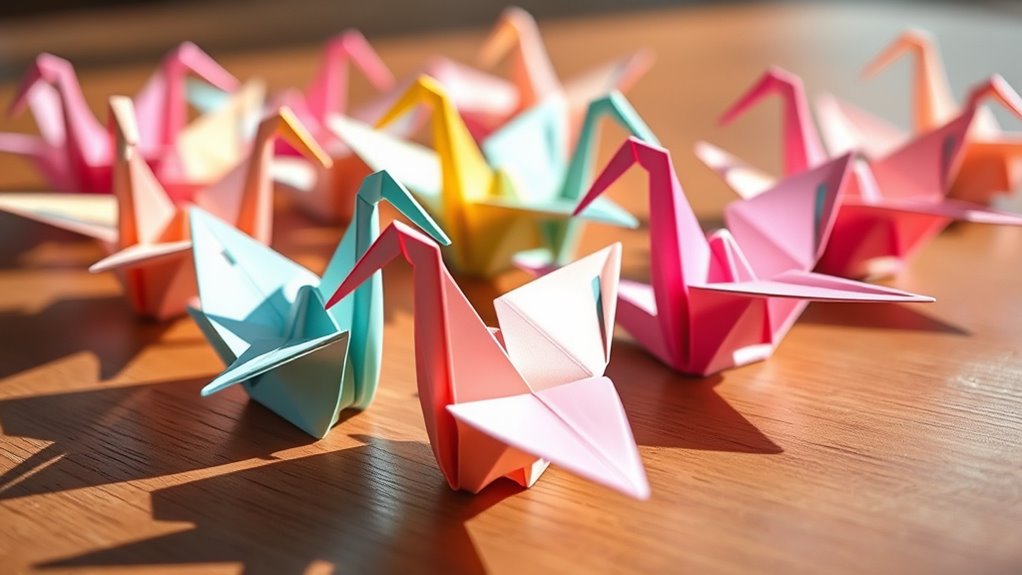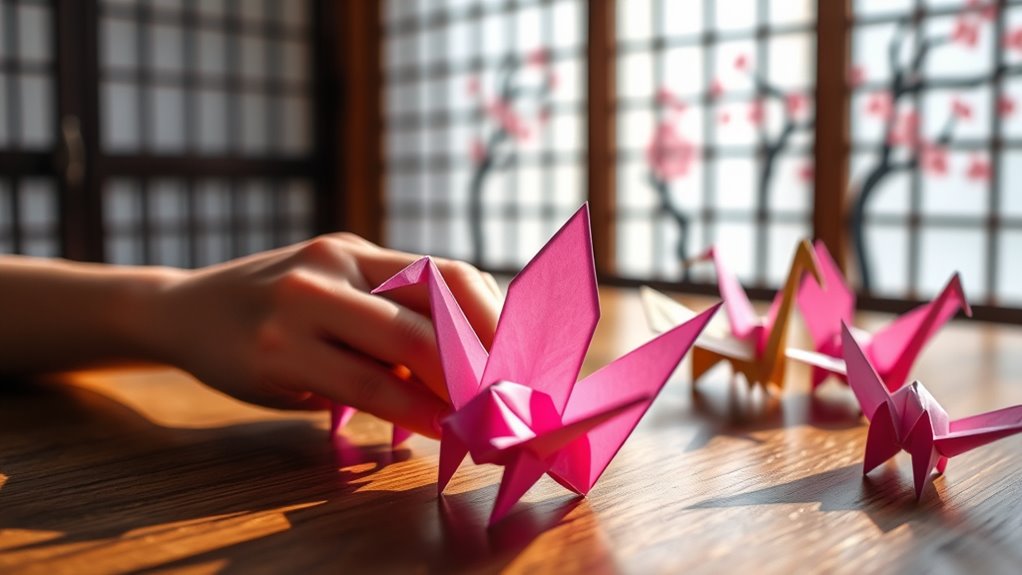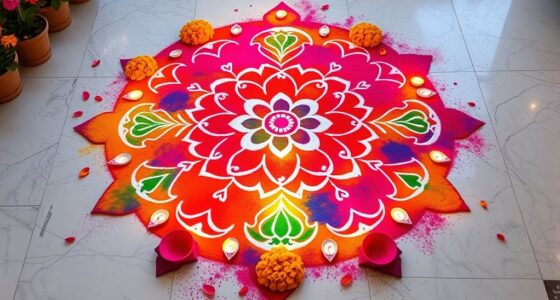Making origami cranes connects you with a meaningful cultural tradition symbolizing peace, hope, and resilience worldwide. By carefully folding a square piece of paper through precise steps, you create a delicate crane that embodies wishes for a better future. This craft goes beyond just paper modeling; it carries powerful messages of compassion and perseverance, inspiring kindness across borders. If you continue exploring, you’ll discover even deeper stories and techniques behind this timeless symbol of harmony.
Key Takeaways
- Origami cranes symbolize peace, hope, and resilience, originating from Japan and gaining global significance after WWII.
- The craft involves precise folding techniques, starting from a square paper, often with meaningful colors or patterns.
- Creating cranes is a meditative process that fosters patience, mindfulness, and emotional connection to cultural traditions.
- The story of Sadako Sasaki and her thousand cranes popularized the crane as a universal emblem of peace and healing.
- Folding cranes transforms a simple craft into a powerful gesture of compassion, remembrance, and hope for a better future.

Have you ever wondered why origami cranes are such a powerful symbol worldwide? It’s because they carry a deep history significance that resonates across cultures. The story behind the crane’s symbolism began in Japan, where the bird is seen as a creature that lives long and is believed to bring good fortune and longevity. After World War II, the crane’s meaning took on even greater importance as a symbol of peace and hope, especially following the tragic events of Hiroshima. The story of Sadako Sasaki, a young girl who attempted to fold a thousand cranes while battling leukemia caused by the atomic bombing, cemented the crane as a universal emblem of peace and healing. When you make an origami crane, you’re participating in a tradition that extends beyond mere craft—you’re connecting with a powerful message of compassion and resilience.
Understanding the history significance of origami cranes helps deepen your appreciation for this art form. It’s not just about creating a folded paper figure; it’s about honoring a symbol that embodies peace, prayer, and hope. The crane has become a universal sign that transcends language and borders, inspiring countless people worldwide to fold cranes as a gesture of remembrance or a wish for a better future. The story behind the crane’s symbolism lends a meaningful context to each fold, transforming a simple piece of paper into a meaningful artifact. Additionally, many organizations and individuals use the crane as a symbol of hope, reinforcing its role as a beacon of optimism in difficult times.
To effectively make an origami crane, you need to master specific folding techniques that have been passed down through generations. These techniques involve precise creases and careful alignment, ensuring that each fold contributes to the elegance and accuracy of the final figure. You start with a square sheet of paper, often choosing one with a color or pattern that adds to its significance. The process involves folding the paper diagonally, creating mountain and valley folds, and then carefully shaping the bird’s wings, neck, and tail. Each step requires patience and attention to detail, as even small misalignments can affect the overall appearance. As you progress, you develop a sense of rhythm and mindfulness, making the act of folding both meditative and fulfilling.
Learning these folding techniques not only improves your craftsmanship but also connects you with a tradition that has touched millions of lives. The patience and precision needed remind you of the importance of hope and perseverance. Each crane you fold becomes more than a craft project; it’s a symbol of peace, a message carried through generations. By understanding both the history significance and practicing the proper folding techniques, you participate in a timeless tradition that celebrates harmony, resilience, and hope for a better world.
Frequently Asked Questions
What Is the History Behind Origami Cranes?
The history origins of origami cranes trace back to Japan in the 17th century, where paper folding became a popular art form. You should know that these cranes hold deep cultural symbolism, representing hope, healing, and peace. When you fold an origami crane, you’re connecting with a tradition that symbolizes good fortune and resilience, especially after tragic events like Hiroshima. It’s a meaningful way to honor peace and remember those affected.
Can Anyone Learn to Fold an Origami Crane Easily?
Yes, you can learn to fold an origami crane easily! With beginner techniques, you’ll find the process manageable and fun. Start with simple steps and practice patience to overcome folding challenges. As you gain confidence, your folds will become more precise. Remember, patience and perseverance help you improve. Even if you face difficulty at first, keep practicing, and you’ll soon be creating beautiful origami cranes with ease.
Are There Specific Paper Types Recommended for Folding Cranes?
You should choose paper with good quality for folding cranes, like traditional origami paper or kami, which is thin and easy to fold. Avoid thick or glossy paper that can make precise folding difficult. Using smooth, crisp paper helps improve your folding techniques, resulting in cleaner, more accurate cranes. Remember, the right paper enhances your experience and creates a beautiful finished piece, especially as you refine your folding skills.
How Many Origami Cranes Are Traditionally Made for Peace Gestures?
You typically make 1,000 origami cranes for peace gestures, a tradition rooted in cultural significance and traditional practices. This number symbolizes hope and healing, especially for those affected by conflict or tragedy. By folding cranes, you participate in a meaningful act that honors peace and resilience. The process itself emphasizes patience and dedication, reinforcing the deep cultural importance of this beautiful gesture for promoting harmony worldwide.
What Are Some Variations of Origami Cranes in Different Cultures?
You’ll find that origami cranes vary wildly across cultures, like a kaleidoscope of regional designs. In Japan, traditional cranes symbolize hope, while in China, they’re combined with dragons for power. Western adaptations might incorporate bright colors and modern patterns. These cultural adaptations highlight how each community personalizes the crane, turning it into a symbol that resonates with local values and stories, creating a rich tapestry of regional designs worldwide.
Conclusion
So, next time you fold an origami crane, remember—you’re not just creating a delicate paper bird. You’re holding a tiny symbol of peace that’s traveled across decades and cultures, yet still only takes moments to make. It’s ironic how something so simple can carry such profound meaning. Maybe all it takes is a folded paper crane to remind us that peace isn’t complicated—it’s just a matter of a few careful folds.






